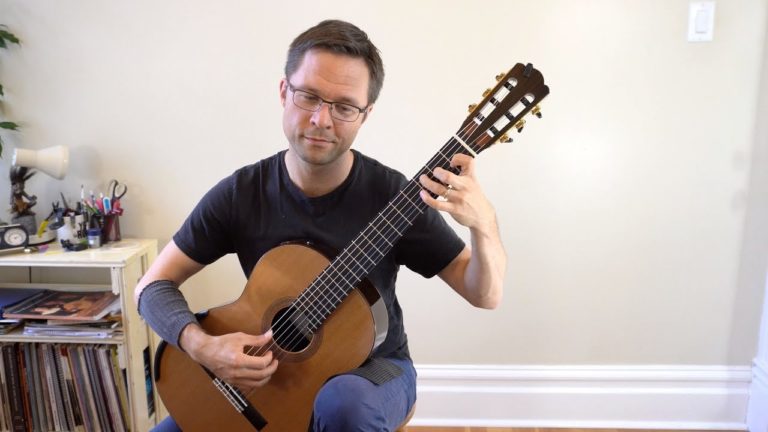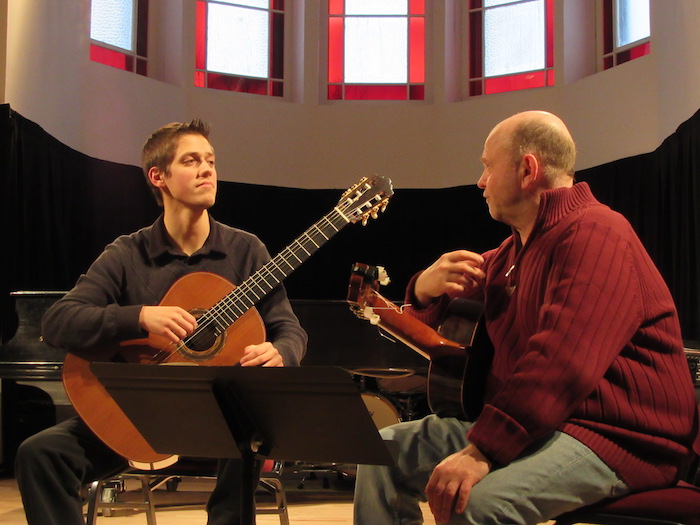This is a guest post by composer & guitarist Frank Wallace.
In my article Loud, or Robust?, I mentioned performing Narváez in a 12th century church. It was magical. It was transformative. I heard every voice of a four-part texture as if it were being sung. I must assume that this is how Narváez and his colleagues and audience of the day heard their music. It is not the same in a carpeted room with soft plaster board walls and absorptive curtains. I’m sure old Luys did not always play in a magnificent acoustic, but the norm in Spain today is very, very different than the norm in America. Floors are NOT covered in rugs and carpet – they are hard tile. A bar in Spain is LOUD – voices carry and reverberate as do the stone streets. It is downright cacophonous. Play a guitar there or a vihuela and it is loud, not muted, and the notes are much more sustained, or vocal, if you will.
Where did Narváez’s music come from? Why did he write what he wrote and from what traditions did he emerge? The vihuela repertoire commonly played on the modern guitar is but a tiny portion of the extant repertoire: roughly 700 pieces contained in seven books. Of that at least half the pieces are arrangements (intabulations) of choral repertoire. And most of the rest are fantasías in the choral, or polyphonic style. The few sets of instrumental variations called diferéncias are in fact quite rare and dance music is virtually non-existent. Some might surmise that dance and diférencias traditions were the more popular style that did not need to be written down. I don’t believe there is any evidence for that however, and even if so, it would have certainly been considered of lesser importance, or sophistication. Miguel Fuenllana makes it clear in his introduction that the purpose of his book is to teach the art of composition through the study of the great masters of his day: Guerrero and Morales, Flecha and the Flemish composers Josquin, Gombert, Willaert, etc. By the very nature of his written format [red numbers in the tablature which are to be sung] he makes it clear that his practice involves singing one part of the texture while playing all the parts. One piece demands that you sing the bass, another the alto and so on through all the voices. Teresica Hermana is a great example of very quick complex polyphony demanding great technical skill of the left hand while singing the bass part [Listen Teresica Hermana].
The first masters of the guitar were thinking vocally – the lute or vihuela were the only way to play all voices at once by oneself. The desire was to experience these vocal masterpieces in the privacy of one’s room. Certainly any professional musician of the day had spent his youth in a choir and was a highly trained vocalist. Keyboards were not yet dominant and orchestras did not exist for another 200 years. Instrumentalism, as we generally think of it, emerged from this vantage point.
What if we were to regain this viewpoint? What if we were to sing our music? What would that entail? On a practical scale, that is a huge topic I do not aim to deal with now, though it is worth noting that communal singing on both small and large scale has become rare in our culture. From a conceptual point of view, there are things we can do as practicing guitarists. We don’t need to add words but rather play with the concept of a constant variety of attack [consonant] and timbre [vowel]. A singer uses consonants to release, or articulate, vowels. There is an infinite palate of vowel sounds, variations in every language and dialect are endless. Each vowel has a distinct color: an a sounds much warmer than an e; an u a little darker than an o. Try to play those two vowels on the guitar. Play other vowels. How do you make an u, or an o? Does each string have any particular vowel color it likes, or can you make all vowels on all strings. If you were to play Lágrima right now, would the first four melodic notes all be the same vowel? Or each different? Try it both ways. Does each nail sound different? How can we use that to our advantage, rather than always trying to even out our sound.
Segovia famously said the guitar is like a mini-orchestra: a flute section here, a trumpet pops out there; the strings alternate with the winds. It’s effective, but not subtle, not moving. Playing as if one were singing demands a constant gradation of tone, subtle or not, given the textures and mood of the music. This idea need not be limited to melodies, any texture can be colored in this manner: arpeggios, repeated chords, pointillistic sections. Indeed the purpose of arpeggio or tremolo is to create a more sustained texture, but that texture can be constantly shifting in hue.
In this scenario, one can take advantage of the inherently different tone of each nail, or each finger’s proximity to the bridge. Don’t just alternate i and m because it’s what you’re supposed to do – rather, explore using one finger or changing not only attack, but timbre for an accented note. Dissonance or consonance can be greatly enhanced by the use of color – try playing the dominant chord nasally and the resolution more roundly: or use an e vowel on the dissonance and an ah to resolve it.
Explore. Have fun experimenting on simple melodic pieces. Go to YouTube or your CD collection and listen to the approach of your favorite guitarists. Are they exploring the full subtlety of timbre the guitar has to offer, or merely making broad gestures in one color, then another.
About Frank Wallace:
Frank Wallace’s compositions are called “contemporary musical emancipation” by NewMusicBox.org. On stage, he is known for his “elegant virtuosity” (Classics Today) and tours internationally as soloist and with mezzo-soprano Nancy Knowles as Duo LiveOak. Wallace is a two-time winner of the NH Individual Fellowship Award, has a BM from San Francisco Conservatory and has served on the faculty of NE Conservatory, Plymouth and Keene State Colleges, Emmanuel College, and Franklin Pierce University as well as many international festivals. Wallace’s complete works and recordings are published exclusively by Gyre Music at www.gyremusic.com.






